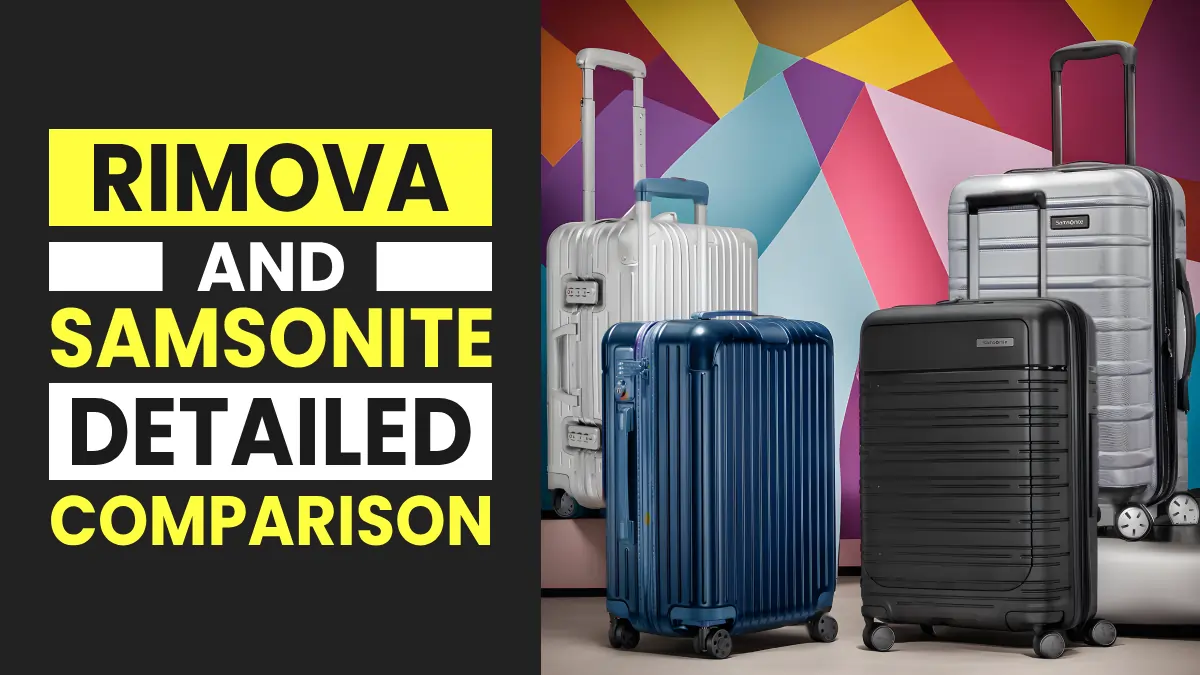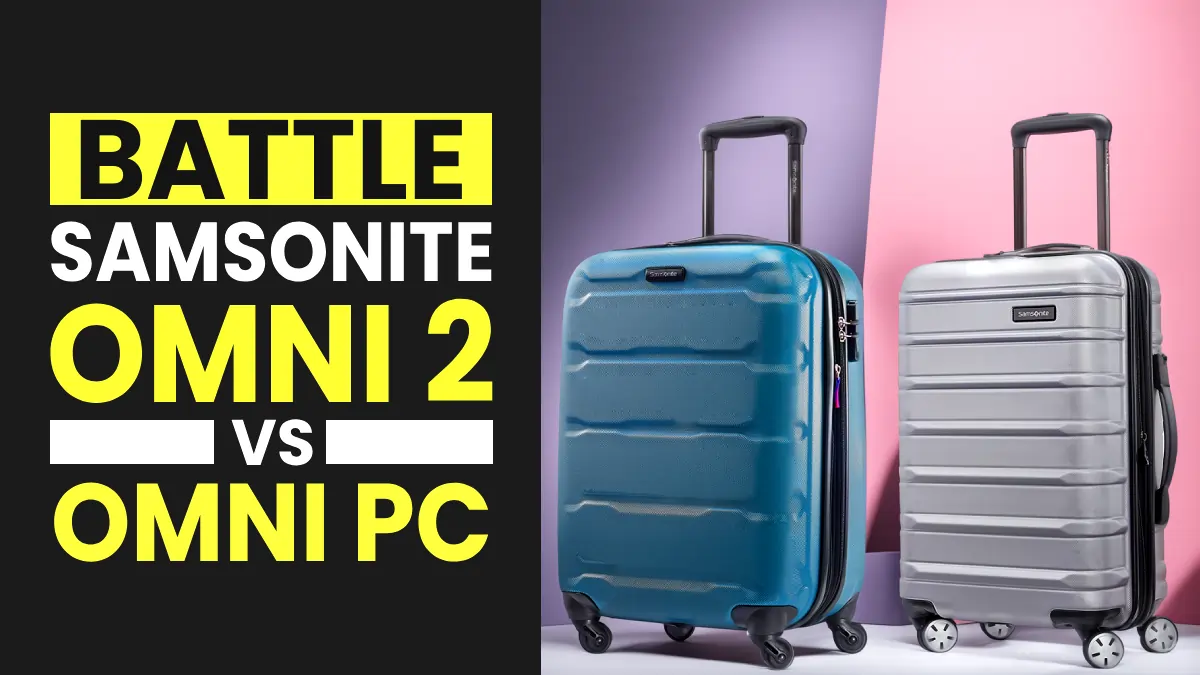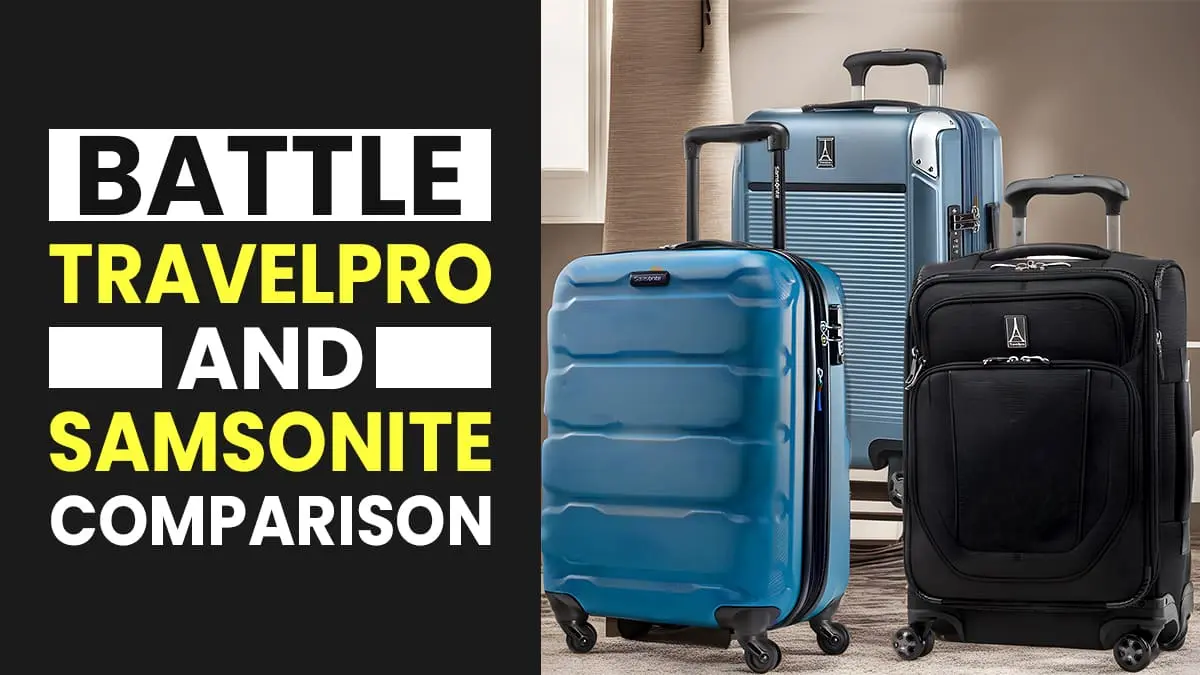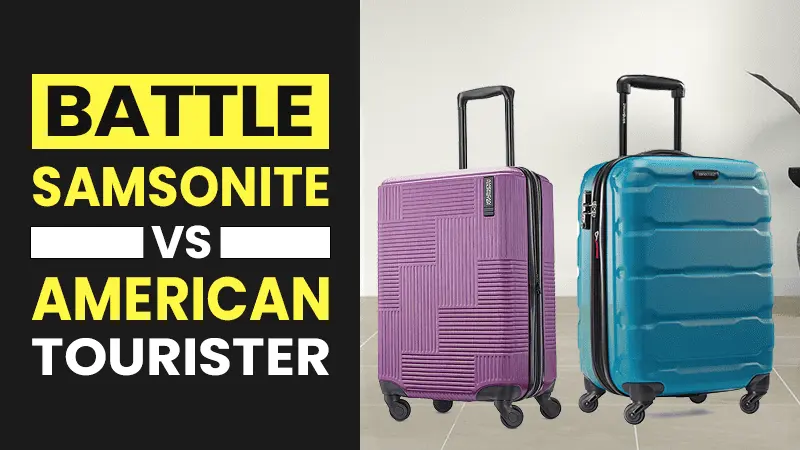Samsonite vs Tumi | Which Brand Should You Choose?
Tumi, undoubtedly, is an excellent brand because of its exceptional durability and longevity. Tumi also offers plenty of features that no other brand offers. But the most important question that comes to mind when we talk about Tumi is:
Is Tumi really worth the price tag, and should you pay for Tumi luggage when it’s five times more expensive than the Samsonite luggage brand?
In this guide to Samsonite vs. Tumi, we’ll compare both brands on different parameters such as durability, features, weight, warranty, and value so that you can get a clear understanding that can ultimately help you choose the perfect piece of luggage.
A Quick Overview of Samsonite
Samsonite has been ruling the luggage industry for a very long time and was established in 1910. And even today, it’s known for its affordability without compromising on durability. With their continuous efforts and dedication, they have achieved the position of having acquired the largest share of the luggage industry.
They started with the manufacturing of wooden trunks, but with time they evolved and adapted to new technologies and different travel requirements. They widen their product range and include suitcases, including rollar and spinner, backpacks, duffel bags, and even laptop bags.
But the most important thing that you may not be aware of is that Samsonite also owns many other brands like American Tourister, High Sierra, Lipault Paris, Hartmann, and even Tumi.
Tumi was also acquired by Samsonite in 2016, so both brands are operated under the same company. However, the purpose and the marketing strategy of both brands are totally different from each other.
A Quick Overview of Tumi
Like Samsonite, Tumi has also been in the luggage industry for a very long time, but it’s not as old a brand as Samsonite. Samsonite was established in 1910, and Tumi was established in 1975.
Tumi luggage falls into the premium category and is more expensive. They target travelers who frequently travel and want something more durable and stylish that can give them a nice appearance wherever they go. Therefore, Tumi luggage is not for the middle class; it targets business class and frequent travelers.
Apart from luggage and suitcases, Tumi also manufactures duffle bags, backpacks, tote bags, and travel accessories to assist you during your travel.
Benefits and Drawbacks of Samsonite Luggage Brand
The Good
- Build Quality: In terms of quality, Samsonite lies in the middle. In its middle-class brands, Samsonite stands out first. They mostly use polycarbonate for their hardside suitcases; therefore, their suitcases are really awesome and last for years, even with frequent use.
- Customers’ Review: They’ve got thousands of reviews because of their dedication. Their products are mostly reviewed and rated between 4 and 4.5 stars out of 5, which is really decent. We rarely find any complaints about durability. However, there are a few negative reviews talking about the poor quality of the zippers and sometimes the wheels.
- Features: They always come with all the essential features, such as a TSA lock, an adjustable handle, single or dual spinner wheels, and a USB charging port in some of their models. They always take care of the buyer’s convenience.
- Reliable Warranty: Considering the price point, their warranty is good enough. They offer different types of warranties, but what you’ll get with your luggage is usually a ten-year warranty, and more importantly, they cover only manufacturing defects.
- Affordable: Their suitcase might seem expensive, but when compared with other brands like Delsey and Travelpro, they’re really affordable considering the features, durability, and warranty. You can easily get a piece of luggage for around $100.
Cons
- Limited Packing Capabilities: Samsonite suitcases are good enough, but in terms of organization, they are not as good as other brands are. Their suitcases usually don’t have enough small pockets for better organization.
- Some models are overpriced. Samsonite is really affordable, but there are still a few suitcases that are really expensive and overpriced. They’re not worth the money.
Benefits and Drawbacks of Tumi Luggage Brand
The Good
- Build Quality: Tumi is one of the most durable and premium brands. They always use the most durable premium materials, like aluminum, polycarbonate, ballistic nylon, and tegris. The materials are incredibly durable. So you won’t face any kind of issues related to build quality, and it’s surely more durable than Samsonite.
- Equipped with Useful Features: Their bags are packed with not only essential features like TSA lock, expansion, and a durable handle but also additional features like suiters, laptop compartments, organizers, and especially the Tumi Tracer, which helps you reunite with your luggage in case it gets lost.
- Good-looking and well-reviewed: Tumi suitcases are generally reviewed at between 4 and 4.5 stars out of 5, which is decent enough. That’s not it; they’re also very appealing and elegant when we compare them with other premium brands.
The Bad
- Expensive: Tumi is really expensive; I’d say they’re overpriced. Considering it is a premium brand, the price still should be around $500 instead of $1000. We’re paying for nothing but the brand logo pasted on the suitcase.
- Not a Reliable Warranty: Since 2004, they used to offer a lifetime warranty, which they must continue, but after that, they stopped it and replaced it with a five-year warranty without reducing the price. They broke the warranty into two parts: one plus four years. That means for the first year, you’re covered unconditionally; they’ll take care of everything, but for the subsequent years, they cover only manufacturing warranties like Samsonite.
Key Differences: Samsonite vs Tumi
While comparing Samsonite and Tumi, it becomes essential for us to measure both brands on different parameters such as material, durability, maneuverability, features, convenience, and warranty so that you can have a clear understanding of which one you should go with.
So let’s start by comparing the durability of both brands.
Which brand makes more durable luggage: Samsonite or Tumi?
Obviously, you might be thinking that Tumi is more durable, and yes, you’re right. but there are plenty of parameters you should think of when it comes to durability. Let’s dive into detail.
Samsonite focuses on middle-class travelers; their luggage is not as durable as that of Tumi but still offers excellent durability for a budget-conscious traveler. In the budget segment, Samsonite is considered the most affordable luggage brand without sacrificing quality.
For hardside suitcases, Samsonite uses polycarbonate, which is the most durable plastic material, but sometimes they also use polypropylene, like in the Samsonite Freeform. The polypropylene material is also as good as polycabonate, with a little less durability but being more flexible.
For softside suitcases, they mostly use polyester material, which is more afforadable but less durable than normal and ballistic nylon.
On the other hand, Tumi is extremely durable; we found no complaint about the built quality of the brand, but considering the price point, Samsonite suitcases also offer excellent durability and become a solid choice.
Tumi uses either polycarbonate or aluminum in their hardside suitcases; undoubtedly, both materials are excellent because there is nothing above them. However, aluminum is heavier than polycarbonate and also increases the price of luggage.
For softside suitcases, Tumi uses ballistic nylon; that’s the most durable softside material, especially when we talk about soft material. Therefore, their suitcases are so durable that they have become the perfect choice, especially for frequent travelers.
Summing up, Tumi is more durable than Samsonite and can last around 10 years. Samsonite also becomes an excellent brand because of its affordability without losing its quality, and their suitcases can last 3–4 years with frequent use. But if it’s used a few times a year, then Samsonite can also prove to be a good companion for up to 10 years.
Who offers better features: Samsonite or Tumi?
Being a premium brand, Tumi offers those features that Samsonite doesn’t offer. Let’s take a look at each feature that both brands offer.
What Samsonite Offers
- TSA-Approved Lock: Samsonite offers TSA combinations in almost all of its suitcases, including carry-ons. A TSA lock offers you better security and peace of mind, which means once you lock your luggage, no one can access it except you and your TSA agent. The default set code of Samsonite locks is 0-0-0; you can set it to yours.
- Single or Dual Spinner Wheels: Most of the suitcases come with single spinner wheels, like the Samsonite Omni PC and Winfield 2. However, there are some suitcases that come equipped with dual spinner wheels with rubber coatings, like the Samsonite Omni 2.
- Compartment and Organization: Most Samsonite suitcases come with very basic compartments. If you open any Samsonite suitcase, you’ll see that most of the suitcases have two main compartments: one with a zipper divider with some small or large pockets, and the other with cross straps. However, you can use packing cubes for better organization of your stuff.
- Expandable Zippers: Similarly, almost all the suitcases from Samsonite come equipped with this feature, giving you the capability to pack even more. They mostly offer the expansion up to 1.5 inches, but for some suitcases, like the Samsonite Omni PC, it’s up to 2 inches.
- Adjustable Wheel Handle: All the suitcases from Samsonite come with a telescopic wheel handle that adjusts to different positions. So no matter what your height is, you can adjust your luggage handle according to your height. The built-in quality of the handles is good enough, but they’re a little flimsy and wobble a little.
- USB charging ports: This feature is not available in all Samsonite suitcases; they offer it in the premium segment. However, there are some budget Samsonite suitcases, like the Samsonite Omni 2 and Centric 2, that are equipped with this feature and make it possible to charge your phone during travel.
What Tumi Offers
Tumi offers all the features that Samsonite offers, like a TSA-approved lock, a USB charging port, an adjustable handle, dual spinner wheels, and an expandable zipper. But the thing to note here is that the quality of those shared features by Tumi is far better than that of Samsonite.
Apart from those features, being a premium brand, Tumi also offers some additional features that no other brand offers. Let’s take a look one by one.
- Expansion System: Samsonite also offers expandable zippers in their suitcases, but the main difference here is that they go far and offer expansion capacity up to 2-3 inches, which is the most when compared to its competitors. So you can have plenty of space for your return trips and pack even more.
- Omega Closure Zippers: Tumi has come with something new because zippers are the second most breakable thing after wheels. They call it the “Omega Closure System”. They provide a separate head on the zippers; anything that can break is the head. It’ll save the entire zipper from being broken, and the head can easily be replaced with a new one. In this way, it can prevent your zippers from getting broken or damaged.
- Tumi Tracer: Tumi offers an integrated tracer that can be used to locate your luggage if it’s lost or stolen. It’s basically a 20-digit identifier number that is located inside the luggage. You’ll have to register with Tumi at the time of purchase, and then it’ll help you find your luggage if it gets lost or stolen.
- Suiter Compartments: The compartments are designed in such a way that they protect your clothes from wrinkles, which is especially helpful if you’re a business traveler and want to attend some meetings. They come with dedicated clothing compartments.
- Luggage Tags: Almost all the suitcases from Tumi come with luggage tags that are attached to the suitcases and help you identify your luggage quickly at the baggage carousel. You just have to fill in your own details in case it gets lost.
Also Related: Samsonite vs. American Tourister Luggage Brands
Which brand makes more stylish and appealing suitcases?
Let’s start with Samsonite again. As mentioned above, both of them have different strategies and targets. Samsonite wants to have something for everyone, including business travelers, frequent travelers, and occasional travelers; therefore, they come with different types of designs and themes, from minimalistic and robust to modern and edgy designs. You’ll find everything.
So whatever your budget is, you’ll surely find something valuable for you.
On the other hand, Tumi plays differently; they target only the premium segment rather than every type of traveler. The basic principle is that we only want to approach those people who want something unique and more premium that can give them a positive impact wherever they go.
Their design aesthetics feel more premium; they follow somewhat similar minimalistic design and colors that look really amazing and give you a unique identity.
Are Samsonite suitcases really lighter than Tumi?
In terms of weight, Tumi luggage is generally one and a half times that of Samsonite. Tumi is the heaviest among all other brands because they want to make their luggage as durable as possible. That’s why they use comparatively thicker material in their suitcases, which ultimately increases the weight of their luggage.
On the other hand, Samsonite is much lighter than Tumi and many other brands while maintaining the quality of the luggage, which ultimately helps you pack more efficiently without exceeding the airline’s weight restrictions.
Therefore, if you’re planning to fly with a budget airline, where the weight restrictions are more rigid, you should surely go with Samsonite instead of Tumi.
Who has received the most positive customer reviews and feedback: Samsonite or Tumi?
According to report data, the sale of Samsonite is much more than that of Tumi. Despite selling thousands of suitcases every month, Samsonite could maintain an average rating of 4.6 out of 5, and that’s really outstanding.
Maintaining positive reviews along with huge sales is an extremely difficult task, and Samsonite has achieved it. However, a little decline has been noticed in the sales and reviews of Samsonite, but it is still leading in the luggage industry.
On the other hand, Tumi also obtained an average rating of above 4.2 stars out of 5, which is also excellent, but we should keep in mind that the sales of Tumi are nowhere close to those of Samsonite.
The negative reviews about both brands totally differ, and we found some negative reviews about Samsonite talking about broken zippers, handles, and wheels. When it comes to Tumi, the main issue we found is about the warranty.
Which brand is better at staying within the airline’s size restrictions?
When it comes to airline size restrictions, Tumi becomes a clear winner just because all its suitcases, including carry-on and checked, fit the size restrictions of most airlines. The carry-on limit for most airlines is 22 × 14 × 9 inches; all of Tumi’s luggage comes within this dimension, so you don’t have to worry about it.
When we talk about checked luggage, the most common size restriction is 62 linear inches. That means that the sum of all of your suitcase sides should not be more than 62 inches. That’s where Tumi plays really well.
For Samsonite, most of their suitcases, including carry-on and checked luggage, don’t fit under the size restrictions. Their luggage is always above the permit size by 1 to 2 inches, which can sometimes cause issues and force you to pay an extra fee.
Samsonite vs Tumi Warranty Terms and Conditions
Samsonite offers three types of warranties, but what you’ll get with your luggage is a 10-year limited warranty. The warranty covers only manufacturing defects; any damage caused by airline staff or by regular wear and tear is not covered under the warranty.
In order to claim the warranty, you’ll have to go to a nearby Samsonite official store and hand it over to them. They’ll ship it for you for a small fee, which will be around $10 to $15. In my experience, at this price point, the warranty offered by Samsonite is decent.
When it comes to Tumi, it offers a warranty only for 5 years; during your first year, you’re totally covered without any conditions. It means whatever happens with your luggage, Tumi is going to fix it without any cost and even without any shipping charges.
Once the first year is over, the subsequent four-year warranty works like the same Samsonite warranty. It means from the second year onwards, Tumi will cover only manufacturing defects, and shipping costs will be on your shoulders. Initially, they used to offer a lifetime warranty that they must continue, but unfortunately, they stopped it in 2004.
Summing up Samsonite is a clear winner in terms of warranty, and the biggest negative about Tumi is their warranty, as expecting a lifetime warranty at this price is a genuine demand. When you compare Tumi with Briggs & Riley, you’ll find Briggs & Riley more beneficial, as they not only offer luggage at a reasonable price but also with an unconditional lifetime warranty.
Who offers better value for money?
Let’s talk about who offers better value for money.
Samsonite offers excellent durability, design, appearance, and maneuverability, along with all the essential features like a TSA lock, telescopic handle, and expandable zippers that you might need during your travel. Samsonite even offers a USB charging port and dual spinner wheels in some of its models, like the Samsonite Omni 2 and Samsonite Centric 2.
All these things you can get for around $100 to $200, which is literally 1/5 of the Tumi luggage price. Both brands are owned by the same company, but the price difference is huge.
Undeniably, Tumi luggage is really excellent; it offers unconditional durability, exceptional features, and a premium appearance, yet the price is really high. They should have kept it around $500 instead of $1000; it would have become a brilliant deal for every type of traveler. In my experience, it’s really overpriced.
In my experience, Samsonite is far better than Tumi when it comes to value. If you take my opinion, Samsonite is an excellent and affordable option to consider, even for frequent travelers, if you can change it to a new one every few years when it breaks, and you can get five Samsonite suitcases for the price of one Tumi luggage.
At the end, the final decision is yours; it depends on your budget and requirements.
Official Resources
Samsonite Official Website: Here, you can find more details about any product you want. You can filter those products for your convenience. You can visit the website by clicking here.
Tumi Official Website: Tumi.com is the official website of Tumi; you can just visit the website by clicking here. Here, you can find any Tumi product according to your needs and also read the warranty terms and conditions.
Final Verdict: Which Brand Should You Consider?
If you take my opinion about picking one brand between the two, I’d prefer going with Samsonite. There are multiple reasons for it. Undoubtedly, Tumi offers exceptional durability and features that Samsonite doesn’t come with.
But considering all the facilities, Tumi is an excellent brand. I’d still say that Tumi is overpriced. The biggest negative about Tumi is its warranty terms and conditions, and the biggest positive is that they usually don’t exceed the airline’s size restrictions for both carry-on and checked luggage.
On the other hand, Samsonite is not as durable as Tumi but still offers excellent durability, even for frequent travelers, and I think changing Samsonite luggage every 4 to 5 years is more beneficial than buying Tumi luggage because you can buy at least 5 high-quality Samsonite suitcases at the cost of one Tumi luggage.
Samsonite doesn’t have additional features like Tumi, but still, it comes with all the essential features you might need. They are also much lighter than Tumi and are mostly made of polycarbonate material. The most important thing is that despite selling thousands of suitcases every month, they could still maintain more positive reviews than Tumi.
Ultimately, the final choice is yours, depending on the budget, requirements, and expectations you have.







